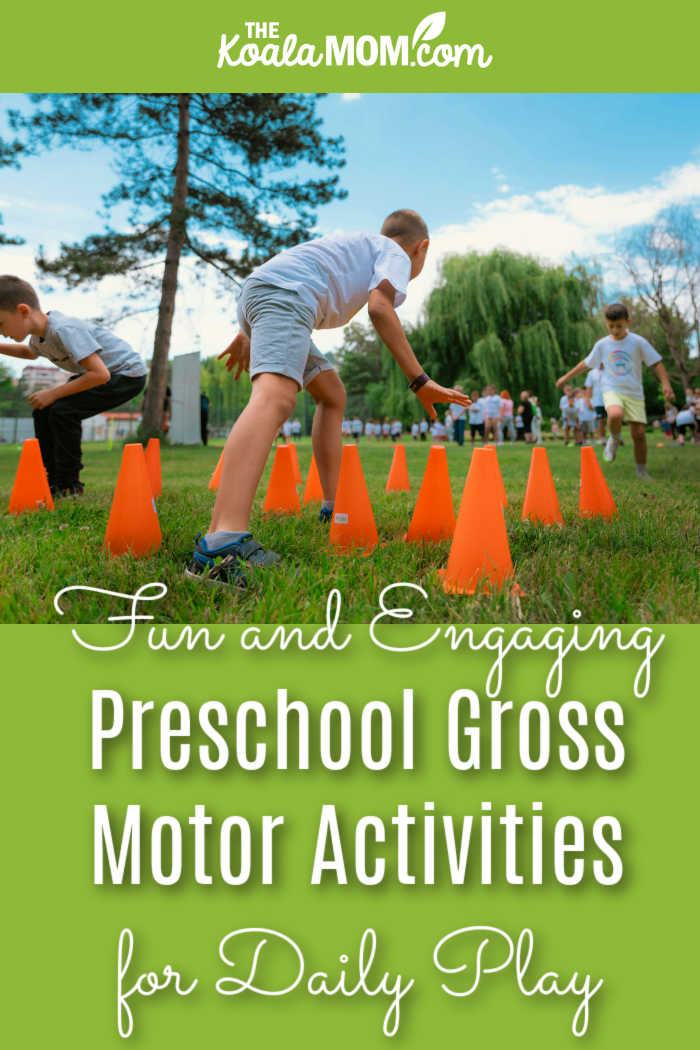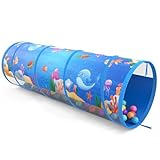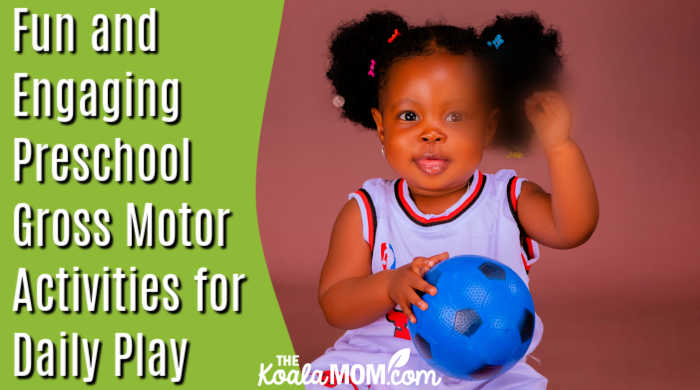Young children have a natural desire to move, explore, and test their abilities. Daily play that focuses on large muscle skills provides children with an opportunity to build strength, coordination, and balance in a fun and engaging way. Gross motor activities help children stay active while also supporting healthy growth and development.
This article introduces simple activities that fit easily into everyday routines, both indoors and outdoors. From playful group games to creative movement challenges, each idea encourages children to stay engaged while practicing important physical skills.

This post contains affiliate links; as an Amazon associate, I earn from qualifying purchases.
Obstacle Course with Tunnels and Cones
 A simple obstacle course with tunnels and cones provides preschoolers with an opportunity to practice balance, coordination, and body control. Children can crawl through a tunnel, weave around cones, and then return to the start for another round. This type of setup keeps them active while also building confidence in movement. (For those of us who live in wet or cold climates, this is a great way to encourage active play indoors when the weather outside isn’t great!)
A simple obstacle course with tunnels and cones provides preschoolers with an opportunity to practice balance, coordination, and body control. Children can crawl through a tunnel, weave around cones, and then return to the start for another round. This type of setup keeps them active while also building confidence in movement. (For those of us who live in wet or cold climates, this is a great way to encourage active play indoors when the weather outside isn’t great!)
Teachers or parents can adjust the course to match each child’s ability. For example, cones can be spaced closer for younger children or placed farther apart for older ones. Adding a line to walk across or a small hurdle to step over adds more variety without making the course unsafe.
These activities support gross motor skills, which include crawling, jumping, and balancing. They also help children learn how to follow directions in sequence, which supports both physical and cognitive growth. If siblings or classmates are participating, children also learn to take turns.
A tunnel and cone course works well indoors or outdoors. It requires only a few items, sets up quickly, and can be rearranged often to keep the activity fresh and engaging. Small variations can also be added each time the course is set up, to make it more interesting or challenging. Kids could also take turns setting it up for each other or for themselves.
Ball Toss and Catch Games
Ball toss and catch games help preschoolers build coordination and focus. A simple underhand toss between two children teaches them to track the ball with their eyes and react with their hands. This activity also introduces turn-taking in a playful way.
 Teachers or parents can adjust the distance to match each child’s skill level. A soft foam ball works well indoors, while larger playground balls suit outdoor play. These choices keep the game safe while still giving variety.
Teachers or parents can adjust the distance to match each child’s skill level. A soft foam ball works well indoors, while larger playground balls suit outdoor play. These choices keep the game safe while still giving variety.
Adding targets such as buckets or hoops creates new challenges. Children can aim and throw the ball into the target, which builds accuracy and control. This also adds excitement and encourages repeated practice.
Group versions of toss games encourage children to work together. For example, they can form a circle and pass the ball around. This setup helps them focus on timing and cooperation while still having fun.
Animal Walk Races (e.g., Bear Crawl, Frog Jump)
Animal walk races give preschoolers a fun way to move their bodies while practicing strength and coordination. Children can line up and race across a space while copying simple animal movements, such as crawling like a bear or hopping like a frog.
These races help kids use large muscle groups in different ways. For example, a bear crawl builds arm and core strength, while a frog jump develops leg power and balance. Each movement targets different skills without feeling like structured exercise.
Teachers or parents can call out a new animal after each round to keep the activity fresh. Kids might tiptoe like a giraffe, stomp like an elephant, or scuttle like a crab. This variety keeps attention high and encourages creativity.
Animal walk races also work well in both small indoor areas and larger outdoor spaces. They require little to no equipment, which makes them easy to add to daily play routines.
Balance Beam Walk Using a Low Beam or Tape Line
A balance beam walk helps preschoolers practice coordination and body control. A low beam or a simple tape line on the floor provides a safe and easy setup for daily play. Both options give children a clear path to follow without the need for special equipment.
Children can step one foot in front of the other across the surface. This steady motion encourages focus and helps build balance skills. For younger children, a wider tape line allows more space to succeed before moving to a narrower path.
Adults can make the activity more engaging by adding simple challenges. For example, children can carry a small toy, clap their hands, or try walking backward across the line. Each variation increases difficulty in a playful way.
This activity also supports social interaction. Children can take turns, cheer for each other, and practice patience while waiting. As a result, the balance beam walk becomes both a physical and social learning experience.
Parachute Play with Group Movement
Parachute play gives preschoolers a chance to move together in a simple and structured way. Children hold the edges, lift the fabric, and lower it as a group. This shared action helps them practice coordination while staying active.
The parachute also encourages teamwork. Each child must match the pace of the others so the fabric moves smoothly. As a result, children learn to listen and respond to group cues instead of acting independently.
Teachers or caregivers can guide the group through different motions. For example, they may ask children to raise the parachute high, shake it quickly, or drop it low to the ground. These changes keep the activity fresh and engaging.
Parachute games also support gross motor skills. Lifting and pulling the fabric strengthens arms and shoulders, while quick movements build balance and control. The group setting adds a social element that makes the activity both active and cooperative.
Gross motor activities provide preschoolers with simple ways to develop balance, strength, and coordination through everyday play. These movements also support focus and confidence, which helps them in both learning and social settings.
Children benefit from a mix of indoor and outdoor play since each space offers different opportunities for movement and exploration. For example, outdoor games encourage larger movements, while indoor activities can focus on control and focus.
By incorporating a variety of activities into daily routines, caregivers help children stay active, engaged, and prepared to learn. This steady practice creates a strong base for healthy growth and future skills.
All activities should be age-appropriate and supervised by an adult. If you have concerns about your child’s motor development, consult a pediatrician or therapist.


No Responses Yet